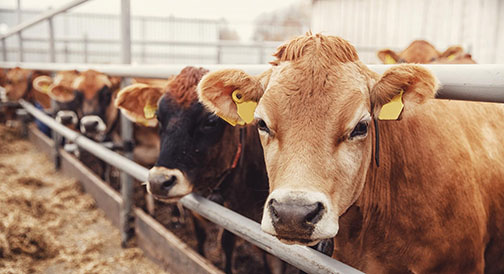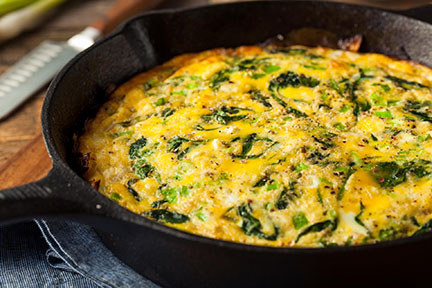ST. LOUIS – April conjures thoughts of spring and new planting seasons. Along those lines, this month also highlights the importance of protecting the environment with the designation of April as Earth Month. Throughout the United States, industries are developing strategies to positively impact the environment, including the U.S. dairy industry. Dairy farms continuously do more with less and use best practices and innovations to reduce environmental impacts. These practices enhance the farms’ economic and social responsibility for the benefit of local communities.
According to the United States Department of Agriculture, family farms comprise 96% of all U.S. farms. Most dairy farms in Missouri and Illinois are family-owned and operated and have fewer than 300 cows. Dairy farmers work where they live and care about protecting the land, water and air for their families, surrounding communities and future generations.
“Dairy farmers work hard at being good stewards of the land and providing excellent animal care,” said Jessica Kassel, a registered dietitian and nutrition educator with St. Louis District Dairy Council. “As a result of dairy farmers’ efforts, the cows produce nutritious milk. Milk provides 13 essential nutrients, including protein, calcium, potassium and vitamin D. Because of this robust nutrition package, the U.S. Dietary Guidelines for Americans recommend three servings of dairy a day. Dairy foods are also an affordable and accessible source of nutrition for many American families.”
Dairy farmers are mindful of the planet and are committed to producing nutritious food through responsible practices regulated by federal and state agencies.

Animal care is job No. 1
Healthy cows are happy cows, and happy cows make more milk. Dairy farmers keep their cows happy and healthy by providing clean and comfortable housing, round-the-clock access to fresh food and water, and medical attention when necessary. Dairy farmers work with a dedicated team that includes veterinarians, animal nutritionists and environmental consultants.
Dairy cows excel at upcycling
Dairy farms upcycle components of crops and food waste from other industries that would otherwise go to a landfill. This includes almond hulls, distiller grains, citrus pulp, soybean meal and cotton seeds. Dairy farmers use these materials, along with corn silage, hay, soybeans and alfalfa, as feed for the cows. Overall, 80% of a cow’s diet cannot be consumed by humans. Cows, in turn, convert their feed into nutritious milk.
Dairy farmers reduce, reuse and recycle water
Water recycling is standard practice on a dairy farm. Dairy farmers can reuse water as many as five or six times. For example, farmers use water to keep milk tanks cool and then reuse it as drinking water for the cows. Farmers also use wastewater to flush barns and to irrigate crop fields.
Manure management
Manure contains nutrients that improve soil quality and crop yield, including nitrogen, phosphorus and potassium. When farmers fertilize soil with cow manure, the soil retains 20% more water. This moisture retention supports crop growth, especially during a dry summer season. In addition, dairy farmers reduce costs and contamination of clean ground water when using manure in place of commercial fertilizers.
Water quality is top-of-mind
Precision farming, cover crops and buffer strips protect waterways by reducing nutrient runoff on farmland. Cover crops help with soil erosion, improve soil health, crowd out weeds, control pests and diseases, and increase biodiversity. Buffer strips are protective zones of permanent vegetation between a farm field and a waterway. Buffer strips slow and filter storm runoff, hold soil in place and reduce the amount of harmful chemicals and microbes that enter waterways. State and local government agencies regularly inspect and test the water on dairy farms.
Manure is a renewable fuel
New methane digester technology heats manure and uses bacteria to break it down into methane-rich biogas. This gas is a renewable fuel that can generate electricity. Farms that use this technology generate enough electricity for their farm and more.
For more information on the sustainability of dairy farms, visit www.stldairycouncil.org or contact Jessica Kassel at 314-835-9668 or jkassel@stldairycouncil.org. Follow St. Louis District Dairy Council on Facebook and Instagram at STLDairyCouncil.
The St. Louis District Dairy Council (SLDDC) is a nonprofit nutrition education organization funded by local dairy farmers. Since 1932, SLDDC has served 131 counties in central/southern Illinois and eastern Missouri as the go-to educational resource and advocate for the role of dairy foods as part of a healthful diet. As the Nutrition Education People, we are proud to spread knowledge to local communities, bridging the gap between local dairy farmers and consumers. The staff is comprised of professionals with experience in nutrition, food service management, education and communication, and we take pride in delivering engaging programs throughout the communities we serve.

Vegetable Frittata
Celebrate spring with this light and delicious vegetable frittata. This versatile recipe is forgiving – use the vegetables and cheese you have on hand. Serve the frittata for breakfast or make breakfast for dinner!
Prep time: 1 hour
Servings: 8
Ingredients
8 large eggs
½ cup milk
½ tsp. salt, divided
½ tsp. pepper, divided
1 cup shredded sharp cheddar cheese, divided
1 Tbsp. olive oil
2 garlic cloves, minced
½ red onion, diced
1 small sweet potato, chopped
1 small zucchini, chopped
1 medium red pepper, chopped
2 cups baby spinach
Instructions
- Preheat the oven to 375˚F.
- In a medium bowl, whisk together the eggs, milk, ¼ tsp. salt and ¼ tsp. pepper. Whisk in ¾ cup cheese. Set bowl aside.
- Spray the sides and bottom of a 12-inch oven-safe skillet with cooking spray. Add olive oil and heat oil over medium heat. Add the garlic. Stir the garlic as it sautés for 30 to 60 seconds. Do not let the garlic burn.
- Add the red onion and sweet potatoes to the skillet. Cook for 5 minutes, stirring the mixture occasionally, until the vegetables begin to soften. Add the zucchini and red peppers. Season the mixture with the remaining salt and pepper. Cook for 5 minutes, stirring occasionally. Add the spinach; stir the mixture until the spinach wilts.
- Pour the egg-and-cheese mixture over the vegetables. Scrape the sides of the pan to ensure all vegetables are in the egg mixture. Cook the mixture for 2 to 3 minutes, without stirring. Once the mixture begins to bubble and set around the edges, sprinkle the remaining ¼ cup of cheese on top.
- Transfer the skillet to the oven and bake for 22 to 26 minutes, or until the frittata is puffy, and the center no longer wobbles.
- Remove the skillet from oven and set on a wire rack to cool for 10 minutes. Slice and serve.
